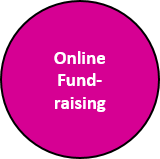
Everybody who’s talking about anything and everything today is online. You should be too.
I’ve written a lot over the past several years about why mastering online social fundraising is critical to nonprofit success (e.g., here and here, just as starters).
A bit later in this article I’ll give you a link to a mini-guide for nonprofit online social fundraising. It really boils down to taking charge of the “customer experience” — which is a huge meme du jour in the for-profit world today.
If you need to persuade someone about why this is important, you can read up about how the digital revolution has changed the way people are influenced to give in Penelope Burk’s Cygnus Research studies from the past several years. Here are some of the indisputable truths:
- People increasingly learn about brands online (yes, your nonprofit is a brand).
- For at least the past five years, 69% of folks have said they prefer online communications to print.
- People increasingly conduct financial transactions online.
- Today, every generation even donates online.
- The fastest growing segment of year-end giving is from online fundraising.
I could go on and on about the why, but I’m going to assume if you’re reading this article you’re already sold. You know you need to do this better than you’re doing it now. You’re just not sure how.
Where to Begin
Before we get started, I want to reassure you. You. Can. Do. This!
There’s lots of technology help online. Just ‘google’ any question you may have. “What are the best online fundraising tools?” “What email provider should my nonprofit choose?” “How do I add a share button?” “How do I insert an image into my Word Press blog post?” “How do I create a thank you landing page?” “How do I create an online peer-to-peer fundraising page?”
Ask and ye shall receive.
If I can do this, and I’m a total troglodyte, so can you.
Trust me.
Solidify the Basics Before You Riff
Beware the shiny object syndrome.
You’ll no doubt hear from board members and volunteers who’ll show you an example of a great campaign they saw elsewhere: “Why don’t we try this?”
This will take you down a rabbit hole.
While it’s fun to try new things, be sure you’ve got the basics in place first. They’re your war horses. Don’t get sidetracked by bells and whistles. They won’t help you if they’re not attached to an engine.
Build Your Online Marketing Engine
You’ve got to build from the ground up.
Were you a rocket scientist, you’d begin with the foundational engine; then boost your payload from there.
Looking at this another way, Richard Dietz, nonprofit technology expert, created what he calls the “Online Hierarchy of Needs” (a riff on the Maslow Hierarchy). In it he shows what he believes to be most essential to your online strategy.
 I agree, and frame it a bit differently.
I agree, and frame it a bit differently.
In a nutshell, your online engine boils down to three basics:
- Clean, attractive website with prominent “Donate/Give” button
- Email (includes ability to capture emails with a big sign-up box on your Home Page)
- One social media channel to begin; add more as you build
Not Instagram; Snapchat; text-to-give; mobile apps; viral video or the like. Those channels will definitely help you when you’re ready to add them on, but they don’t stand on their own. They bolster your core campaign strategies.
First things first.
Content Marketing is King
You’ve no doubt heard the old adage that “content is king.” In online social fundraising, content marketing is king.
Just like gas fuels your car’s engine, your donor-centered content fuels your online fundraising and marketing engine.
There’s no point having a social media and email communications and website fundraising strategy without a content marketing strategy. It’s a total waste of time.
Your campaign content should always be about meeting your donors’ needs
People don’t give the first time they come into contact with you.
You’ve got to connect with them over time, consistently, in a manner that connects with their interests.
Multiple times. Through multiple channels.
If you don’t have an intentional donor-centered content marketing strategy, you’re apt to revert to boring, ego-centered content that will not meet your audiences’ needs. And you’re apt to deliver it sporadically, so you don’t really develop name recognition or a position as a thought leader in your area of expertise.
Without consistently delivered significant content, people won’t find you. Even if they do, no one’s really going to visit your website more than once or twice. You won’t get shared. Over time, you’ll stop being read. Your tree will fall in the forest, but no one will hear it. Yet most nonprofits won’t even know this is happening, because they don’t measure engagement. Engagement means actions; not just likes and follows.
There is a classic marketing continuum that takes folks from awareness… to interest… to engagement… to investment. Where are your prospective donors along this continuum, and what must you do to get them to the next step?
HINT: Hot content… leads to social ignition… leads to fiery, desirable engagement.
Build Thoughtful, Holistic Online Campaigns with Repetition Baked In
You may be familiar with the marketing Rule of 7. It states that it takes about 7 touches before folks feel comfortable making an investment decision. It may take even more in today’s information-overload economy.
How many touches are you planning for?
The point is not the specific number, but the need for repetition. Across multiple channels.
Buyers just can’t trust you and make the buying (or giving) decision the first time they encounter your message.
Your fundraising campaign effort should be repetitive, consistent and multi-layered. You can’t simply send a one-time email and expect your best results. You need to plan thoughtfully.
Don’t Make Your Online Strategy an Afterthought
Many nonprofits spend oodles of time developing their offline direct mail campaign. From theme… to text… to visuals… to design… to who the letter will come from… to envelope teaser copy… to type of stamp… to when the campaign will drop… to how many times you’ll mail… to how you’ll segment your list… to thank you strategy.
Then, at the last minute, they slap a lone email together and send it out.
- The copy and design may not match their mail campaign.
- Timing may not be integrated with their offline strategy.
- There may be no user-friendly donation page or thank you landing page.
- The thank you may be simply an automatically generated receipt.
Yipes stripes!
You need to spend just as much time – if not more – on your online campaign strategy.
Why? It’s 2017.
Everyone, more or less, is online.
Regardless of how your money comes in (and most nonprofits still receive a majority of donations through the mail), you never know what prompted folks to respond.
Remember the “Rule of 7” (see above).
Only after folks receive your message numerous times online (including social media), are they prepped to respond to your direct mail appeal.
Plus your ROI online is greater than offline. Why? No postage or printing or paper, of course.
Your online strategy bolsters your offline strategy.
And here is the link I promised to The Nonprofit Mini-Guide to Online Social Fundraising, with more information as to why this is important and how you can use social media to discover fundraising opportunities.
Part 1 Review:
- Begin with your well-oiled content marketing engine and plan. Get your basics in place. Website. Email. Social media channel(s). Put everything in writing. Include a timeline so you build incrementally. Allocate budget and hire/train staff. It won’t happen in a vacuum, and it won’t build itself.
- Build an intentional donor-centered content marketing plan. What content you’ll offer. What delivery mechanisms you’ll use. Who you’ll target. How often you’ll deliver your messages and calls to action. How you’ll get your content shared by others.
- Build an online fundraising campaign strategy that’s integrated with your content marketing plan. Use content marketing to predispose donors to give. Use it to inspire continued engagement and investment.
Watch for Part 2 later this week. Meanwhile, if you have comments please share them below.
Want to Stand Out and Build Loyalty Using Social Media?
 Keeping pace with rapidly evolving mediums of communication these days is no small task. This is a simple guide to help you evaluate what’s worth doing/not worth doing for your nonprofit.The Tip List + Worksheet will walk you through a step-by-step process of evaluating what makes sense for you. Grab it here.
Keeping pace with rapidly evolving mediums of communication these days is no small task. This is a simple guide to help you evaluate what’s worth doing/not worth doing for your nonprofit.The Tip List + Worksheet will walk you through a step-by-step process of evaluating what makes sense for you. Grab it here.
Photo by Claire Axelrad as part of a series: The Art of Philanthropy – ‘Love of Humankind’ – as Seen Through the Prism of the World’s Art Museums






An online marketing presence is absolutely unavoidable nowadays. Whether you have a physical store or just a website, you have to advertise your products and services. Digital marketing has become an indispensable tool for business growth.brand and protect your online reputation